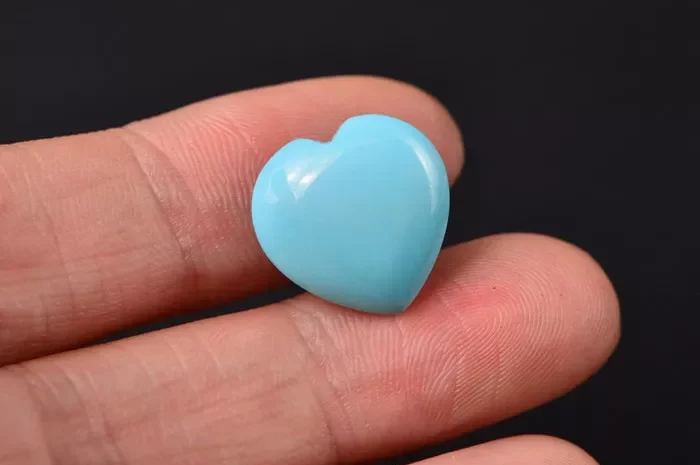Turquoise, with its captivating blue-green hue, has been cherished for centuries for its beauty and cultural significance. Among the various types of turquoise, Sleeping Beauty turquoise is highly sought after for its vibrant color and smooth texture. However, due to its popularity, there’s a risk of encountering counterfeit or treated stones in the market. This guide aims to equip you with the knowledge to identify genuine Sleeping Beauty turquoise with confidence.
Understanding Sleeping Beauty Turquoise
Sleeping Beauty turquoise is a type of turquoise that is mined in the Sleeping Beauty Mine in Globe, Arizona. It is known for its striking sky-blue color, often with little to no matrix (veining or webbing). The stone’s color and clarity make it highly desirable for use in jewelry and other decorative items.
Identifying Genuine Sleeping Beauty Turquoise
1. Color and Clarity
The most notable feature of Sleeping Beauty turquoise is its vivid blue color. Genuine stones typically have a consistent, uniform color throughout, without any noticeable variations or discolorations. The clarity of the stone is also important. Authentic Sleeping Beauty turquoise is usually free of significant inclusions or matrix, although some stones may have minor veining or spots.
2. Hardness
Turquoise is relatively soft compared to other gemstones, with a Mohs hardness of around 5 to 6. This means it can be scratched easily by harder materials. However, Sleeping Beauty turquoise is known for its durability and hardness, often ranking at the higher end of the Mohs scale. A genuine stone should not be easily scratched by a steel nail or knife.
3. Weight
Sleeping Beauty turquoise is denser than many other types of turquoise, which means it should feel heavier than expected for its size. However, this method may not be foolproof, as some counterfeit stones may be artificially weighted.
4. Matrix and Veining
While Sleeping Beauty turquoise is known for its lack of matrix, some genuine stones may have minor veining or webbing. However, these should be fine and not overly pronounced. Be wary of stones with heavy matrix or veining, as they may be dyed or treated to resemble Sleeping Beauty turquoise.
5. Price and Source
Genuine Sleeping Beauty turquoise is highly valued and can command a premium price. Be cautious of stones that are significantly cheaper than market value, as they may be counterfeit. Additionally, purchasing from reputable sources or certified gemologists can help ensure the authenticity of the stone.
Common Treatments and Counterfeits
1. Stabilization
One common treatment for turquoise, including Sleeping Beauty turquoise, is stabilization. This involves impregnating the stone with a clear resin or polymer to enhance its durability and color. While stabilization is a widely accepted practice, it’s important to be aware that stabilized stones are not considered natural and may not command the same value as untreated stones.
2. Dyeing
Dyeing is another common treatment for turquoise, where the stone is soaked in a colored solution to enhance or alter its natural color. This can be difficult to detect, especially if the dye is applied evenly and matches the natural color of the stone. However, careful examination under magnification or by a trained gemologist may reveal inconsistencies in color or texture.
3. Reconstituted Turquoise
Reconstituted turquoise is a composite material made from small pieces of turquoise that are crushed and mixed with a binding agent. The resulting material is then shaped into a desired form. While reconstituted turquoise can be visually similar to natural turquoise, it lacks the durability and value of genuine stones.
Conclusion
Sleeping Beauty turquoise is a beautiful and highly prized gemstone, but its popularity has led to an increase in counterfeit and treated stones in the market. By understanding the characteristics of genuine Sleeping Beauty turquoise and common treatments and counterfeits, you can make informed decisions when purchasing or evaluating turquoise.
FAQs About Sleeping Beauty Turquoise
1. How can I ensure that the Sleeping Beauty Turquoise I’m buying is authentic?
Purchase from reputable sellers who can provide information about the stone’s source and authenticity. If possible, ask for a certificate of authenticity or consult a gemologist.
2. Are there any tests I can do at home to check if my turquoise is real?
A simple test is to rub the stone against a piece of unglazed porcelain; if it leaves a scratch, it’s likely genuine. However, this test may not be foolproof, and it’s best to consult a professional if you’re unsure.
3. Can Sleeping Beauty Turquoise have a matrix?
Yes, but the matrix should be minimal and delicate. Heavy, dark matrix or large patches of matrix are signs of imitation or other types of turquoise.
4. What is the best way to clean and care for my Sleeping Beauty Turquoise?
Clean gently with a soft cloth and mild soap, avoiding harsh chemicals and ultrasonic cleaners. Store in a soft pouch or cloth to prevent scratches.
5. Is Sleeping Beauty Turquoise always blue?
Yes, Sleeping Beauty Turquoise is known for its distinctive sky-blue color. Be cautious of stones that are too bright or have a greenish tint, as these may not be genuine.


